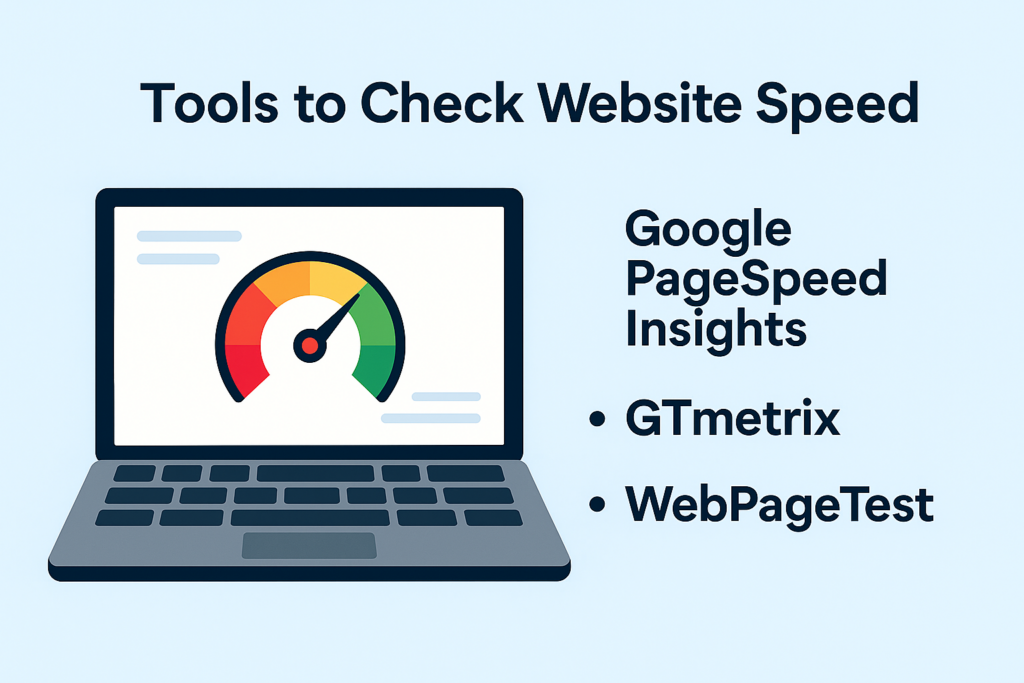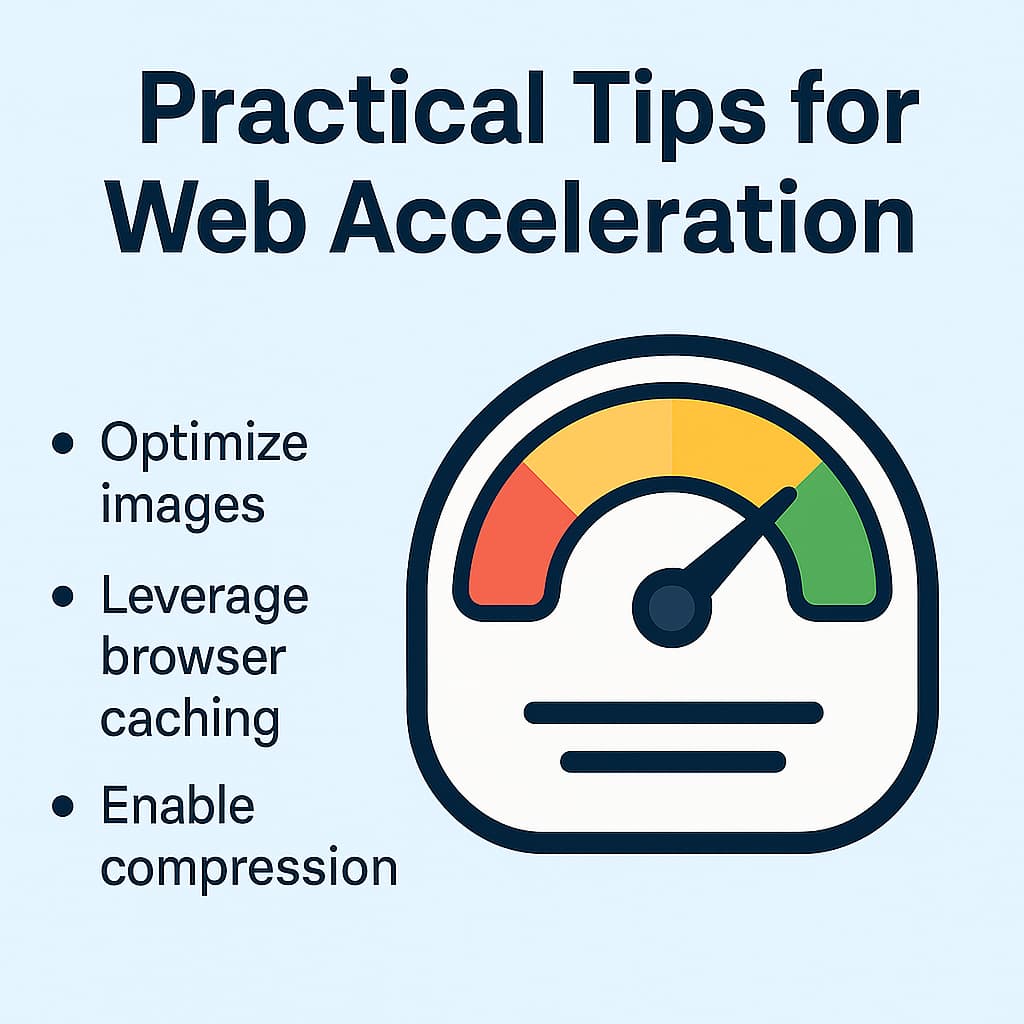
How to Speed Up Your Website and Improve Your Google Ranking
Published: June 18, 2025
Every second counts when it comes to your website’s loading time. Both your visitors and Google expect pages to load quickly. If your site is slow, people will lose patience – over half of mobile visitors leave a site that takes more than 3 seconds to load. Google is well aware of this, which is why page speed is included among its ranking factors. Slow-loading pages frustrate users and lead to higher bounce rates, which negatively impacts your search rankings. In short, a faster website means happier visitors and better visibility on Google.
In this post, we provide a general, easy-to-understand guide for small business owners on speeding up their websites and boosting their Google rankings. We’ll explain why page speed matters, how to measure it with popular tools, and what specific steps you can take – either on your own or with the help of a professional – to make your website faster and more effective.
Why Website Speed Matters
Better User Experience: Visitors expect a fast and seamless experience on your site. Slow loading causes frustration – the slower the page, the more likely a user is to abandon it and go elsewhere. Statistics show that 53% of users will abandon a mobile site if it takes longer than 3 seconds to load. A fast site creates a positive impression: users are more likely to stay longer, view more pages, or complete a purchase or inquiry if everything loads quickly.
SEO Advantage: Google openly uses site speed as a signal in its search ranking algorithm. As far back as 2018, Google’s “Speed Update” made loading speed a factor for mobile search rankings, and since 2021 speed has been a central part of Google’s Core Web Vitals metrics for page experience.
This means faster websites have an edge and tend to rank higher on Google compared to slower ones (all else being equal). Beyond this direct effect on the algorithm, speed also has indirect effects – slow sites often have higher bounce rates, which can signal to Google that users aren’t finding what they need. Conversely, a fast, responsive site provides a good experience and keeps users engaged longer, which can positively influence SEO.
Conversions and Business Outcomes: Speed also impacts your bottom line. For example, Amazon famously found that a one-second slowdown in page load could cost them $1.6 billion in annual sales. For a small business, the scale is different, but the principle holds – a faster site means more chances that visitors will take desired actions (buy a product, send an inquiry, sign up for a newsletter, etc.). Page speed should be a vital part of your digital strategy because it directly affects user satisfaction, SEO, and conversion rates. Simply put, a slow website can be detrimental to business, while a fast one sets you up for success.

Tools to Test Your Website Speed
Before you start making improvements, it’s important to measure your site’s current speed and identify bottlenecks. Fortunately, there are free online tools that provide detailed insights into your site’s performance and offer suggestions for improvement. Here are three of the most popular tools you should try:
Google PageSpeed Insights
Google PageSpeed Insights is a free tool by Google for testing a webpage’s performance on both mobile and desktop. Just enter your page URL and click “Analyze” – the tool will examine your page’s content and generate suggestions to make that page faster. The report includes a performance score (0 to 100) for mobile and desktop, with higher scores indicating better performance. PageSpeed Insights highlights key user experience metrics (like Largest Contentful Paint, Cumulative Layout Shift, etc.) and provides concrete recommendations. For example, it may flag large images that need optimization, suggest minifying CSS/JS files, or enabling caching. This tool is an excellent starting point – you’ll quickly learn what’s slowing down your site and get guidance directly from Google on how to fix it.
GTmetrix
GTmetrix is another popular website speed analysis tool. It’s free for basic use – simply input your site’s address and you’ll receive a detailed report. GTmetrix tells you how your website performs, why it’s slow, and how to optimize it. It combines Google Lighthouse metrics with additional analyses to grade your site’s performance. One of GTmetrix’s strengths is its waterfall chart, which visually breaks down the loading timeline of every element (images, scripts, stylesheets, etc.) on your page.
This helps you pinpoint exactly which elements are causing delays. GTmetrix also lets you choose the test location and device, which is useful if your audience is spread across different regions or if you want to specifically test mobile performance. The report will offer recommendations — for instance, to compress a specific image, enable compression, or defer non-critical scripts. All these insights help you identify bottlenecks and address them one by one.
WebPageTest
WebPageTest is an advanced open-source tool for website performance testing, widely used by professionals. It’s available for free at webpagetest.org and allows for very granular tests. This tool lets you run tests from various geographic locations, different browsers, and network speeds, which can simulate real user conditions. WebPageTest provides a comprehensive analysis of your page load – including total load time, time to first byte (TTFB), a filmstrip view of the loading process, and detailed breakdowns of each page element.
The results highlight where the slowdowns occur and offer suggestions for improvement. WebPageTest is one of the oldest and most trusted testing services (launched in 2008 as an internal project and later open-sourced). While its reports are very detailed, you can focus on the key metrics and the top recommendations it gives. For small businesses, WebPageTest is useful when you want to dive deeper – for example, to test how your site behaves on a slow 3G connection or under different conditions, giving you a complete picture of your site’s performance.
(Note: In addition to these, there are other tools like Pingdom, Uptrends, or even built-in browser tools (Chrome’s Lighthouse audit). However, starting with PageSpeed Insights, GTmetrix, and WebPageTest will provide plenty of information to work with.)

Practical Tips to Speed Up Your Website
After testing your site and identifying potential issues, it’s time to start optimizing. Below are key steps and best practices to make your website load faster. Most of these tips you can implement yourself or with the help of your web developer:
- Optimize Your Images: Large image files are a common culprit for slow pages. Ensure that all images on your site are properly compressed and scaled. For example, avoid uploading a 4000px wide image if it will display at 400px – resize it beforehand. Also, use modern formats like WebP or optimized JPEG/PNG which reduce file size while maintaining quality. There are many tools to help with this: image editing software or online compressors, as well as plugins for CMS platforms (e.g., WordPress plugins that automatically compress images). The result of image optimization is significantly faster load times, especially on mobile devices and slower networks.
- Enable Caching: Caching allows certain elements of your site to be “remembered” either in the user’s browser or on the server, so they load faster on subsequent visits. When caching is properly configured, returning visitors don’t have to re-download the same files (like your logo, CSS, or script files) each time, which dramatically reduces load times for repeat visits. Make sure your website has browser caching enabled – this can often be done via your site’s .htaccess settings or simply by using a caching plugin if you use a platform like WordPress (e.g., WP Super Cache, W3 Total Cache). Without browser caching, a site can significantly slow down the user experience. By enabling caching, you ensure that frequent visitors and subsequent page views load much faster.
- Choose a Fast Web Host (Server): Your web hosting plays a fundamental role in your site’s performance. Cheap or overcrowded servers can have slow response times, meaning it takes too long for your webpage to start delivering content. If you notice that even simple pages take a while to begin loading, your host might be the issue. Consider upgrading to a better hosting plan or a provider known for speed. Modern hosting solutions (e.g., VPS, cloud hosting, or specialized WordPress hosting) often offer faster servers, SSD storage, and even built-in caching mechanisms. A faster server reduces processing time and speeds up content delivery. Also pay attention to server location – if your audience is mostly in one country or region, hosting your site on a server in that region (or using a CDN) can help reduce latency. In summary, a quality host is the foundation of a fast and reliable website.
- Use a Content Delivery Network (CDN): A CDN is a network of servers around the world that delivers your content from the location closest to the user. This is especially useful if your visitors come from various geographic regions. For example, if your main server is in Europe, a visitor from the US might experience slower loading due to distance. A CDN solves this by serving static content (images, CSS, JS, etc.) from a server that is near the user, thereby reducing latency and speeding up load times. Popular CDN services like Cloudflare, Akamai, or CloudFront can be integrated into your site easily. Aside from speed, CDNs can also reduce the load on your main server and provide extra security (e.g., DDoS protection). For small businesses, many CDN providers offer free plans which are sufficient to get started.
- Minimize Unnecessary Scripts and Plugins: Take a look at your site’s code and plugins – do you really need all of them? Each additional JavaScript or CSS file, each widget or plugin can potentially slow down your site. Remove anything that isn’t essential for functionality or user experience. Also, optimize your code: minify your CSS and JavaScript (this means removing spaces, comments, and unnecessary characters to shrink file size) and consider combining files so that fewer HTTP requests are needed. There are many tools and plugins that can help minify and combine files. The principle is simple: fewer and smaller files = faster loading. Additionally, defer loading of scripts that aren’t needed immediately (using the defer or async attributes for script tags) so that the critical parts of your page can render quickly.
- Ensure Mobile Optimization: Remember that the majority of users are now browsing on mobile devices. Google has moved to a mobile-first index, which means the mobile version of your site is primarily used for ranking considerations. Therefore, speed optimization must also consider mobile performance. Use responsive design that adapts to smaller screens and avoid formats or elements not supported on mobile (like Flash). Pay attention to file sizes – mobile users often have slower connections, so optimized images and minimal code are even more crucial. Tools like Google’s Mobile-Friendly Test can help verify if your site is mobile-optimized, and PageSpeed Insights provides separate mobile performance results. In short, mobile speed and user experience are not optional – a site that loads quickly and correctly on smartphones will keep visitors happy and maintain strong search rankings.
Conclusion
Speeding up your website might sound technical, but as we’ve shown, there are many straightforward steps a small business owner can take. Start with measurement – leverage tools like Google PageSpeed Insights, GTmetrix, or WebPageTest to find out where the issues lie.
Then implement key optimizations: compress your images, enable caching, evaluate your hosting (consider upgrades or a CDN), streamline your code and plugins, and don’t forget mobile optimization. Every improvement, no matter how small, will contribute to a better user experience and SEO.
Remember, page speed isn’t just about “niceness to have” – it directly affects how many users stay on your site, how many convert into customers, and whether Google promotes your pages over competitors. If you’re not sure how to implement something, consider consulting an expert or a web developer – but many of these tips you can do yourself with a bit of research. In the end, investing time in speed optimization is one of the most cost-effective ways to boost your online success. A faster website means happier visitors, higher search rankings, and a more successful business.
New web is waiting for you
We turn your website visitors into euros. Contact us and increase your profits today!